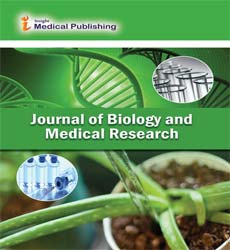Proteomics is Even More Important to Improve the Clinical Outcomes of these Patients
Arnaud Droit*
Department of Biochemistry and Molecular Biology, University of Southern Denmark, Campusvej 55, DK-5230 Odense M, Denmark.
*Corresponding author: Arnaud Droit, Department of Biochemistry and Molecular Biology, University of Southern Denmark, Campusvej 55,
DK-5230 Odense M, Denmark. E-mail: Arnaud@gmail.com
Received Date: November 03, 2021; Accepted Date: November 17, 2021; Published Date: November 24, 2021.
Citation: Droit A (2021). Proteomics is Even More Important to Improve the Clinical Outcomes of these Patients. J Biol Med Res. Vol.4 No. 7: e001
Editorial note We expect more studies on proteomics-dominated multi- and trans-omics to paint out a dynamic, multi-level, multidimensional picture of molecular mechanisms in the single-cell or targeted cell population to elucidate the regulation of genegene, gene-protein, and protein-protein interactions, and define proteome-wide strategy of disease-specific biomarker and therapeutic target discovery and development. We hope that the current issue will be the initiation and stimulation of proteome-based investigations to explore molecular mechanisms in cell functioning and responses to drugs. Proteomics is a powerful tool to provide significant value and impact in understanding molecular mechanisms of disease, identify disease-related biomarkers, and validate therapeutic effects. Proteomics is even more important to improve the clinical outcomes of these patients when proteomic profiles are integrated with clinical phenomes, tissue imaging profiling, and trans-omics. We also believe that proteomics can be a new light in cell biology and toxicology and invited Prof Gyorgy Marko- Varga, a world-leading scientist in translational proteomics, to organize this special issue entitled “Translating Proteomics- and Genomics-Medicine into 21st Century Cancer”. This will be a starting point for the journal of Cell Biology and Toxicology to focus on developing a deeper understanding of disease-specific proteomic profiles, mechanism-based proteomic regulation, protein-dominated cell-cell communication, and interaction between protein with DNA or RNA. Proteogenomics is an important approach to multidimensionally identify disease-specific functional biomarkers, neoantigens, therapeutic targets, and 3D genome dysfunction. Gil et al. emphasized the significance of integrating proteogenomics with customized protein sequence databases generated from patient-specific genomic and transcriptomic data to characterize comprehensive molecular functions and target malignant melanoma. With clinical trans-omics (proteogenomics, clinical phenomics, radiomics, metabolomics), mass spectrometry–based imaging can showcase the spatial distribution actions, efficacies, toxic severities, or metabolites of drugs within tissues at single-cell resolution as more efficient and safer strategies for the treatment of melanoma. In addition to the concept that clinical phenomes are integrated with molecular multi-omic profiles, this comprehensive strategy demonstrates the merge of clinical phenomes in patients with melanoma with tissue imaging and heterogeneity, digital pathology, machine learning, artificial intelligence, biobanking, and sample quality, as well as proteomic profiles. In the present issue, Gil et al. provides a new insight for better understanding of genes to protein expression and their function in malignant melanoma by integrating disease-associated mutations of genes and single amino acid variants of proteins with proteomicsdominated clinical trans-omics, e.g., post-translational modification, pathway signaling, phosphorylation, or acetylomics of targeting proteins. Furthermore, proteogenomic profiles can be characterized for new therapies which aim to discover disease-specific signaling proteins, metabolic enzymes, and tumor antigens and provide strategic guidance of cancer precision therapy. Different from multi-omics, trans-omics emphasizes the gathering, spanning, and transparent pointing of various omics layers in different forms, which can hardly have perfect and precise matching. Ansari et al. presented an example of proteogenomic studies for precision diagnostics and treatment in patients with pancreatic cancer and listed target molecules as “trans” points through which multiple omic layers functionally cross. Those “trans” points can be modeled as predictive nodes connecting multiple dimensional networks of omics layers/ datasets and are automatically analyzed by the artificial intelligence system with machine learning capacity. With the development of omic measurements, multi-omic profiles in single-cell levels can be characterized and integrated into a single-cell-like system with computerized databases, digitalized informatics of biological elements, and programmed function and signals named “an artificial intelligent single cell” .When compensated with cell functional and morphological phenotypes and clinical phenomes, single-cell trans-omics provide a new approach to systemically understand molecular interactions, communications, and mechanisms in the disease, and can dynamically monitor alterations of single-cell gene/ protein expression and networks in patient response to therapies.
Open Access Journals
- Aquaculture & Veterinary Science
- Chemistry & Chemical Sciences
- Clinical Sciences
- Engineering
- General Science
- Genetics & Molecular Biology
- Health Care & Nursing
- Immunology & Microbiology
- Materials Science
- Mathematics & Physics
- Medical Sciences
- Neurology & Psychiatry
- Oncology & Cancer Science
- Pharmaceutical Sciences
